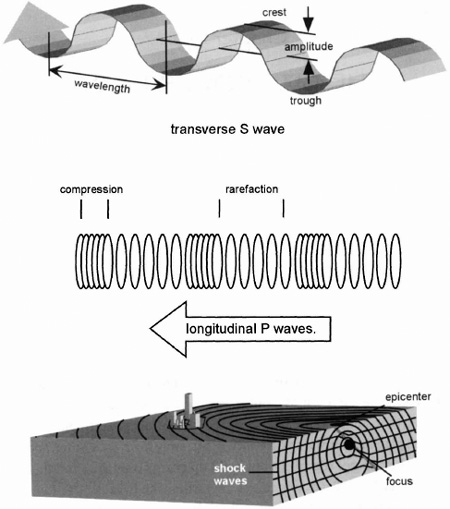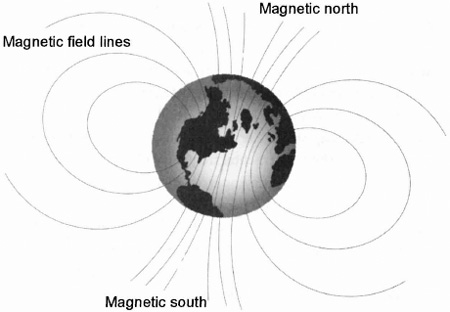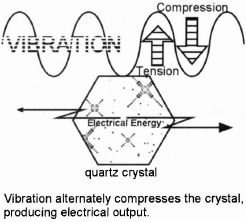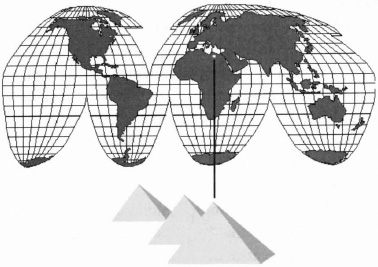The Giza Power Plant (19 page)
Chapter Eight
THE GIZA POWER PLANT

T
he Earth is a dynamic, energetic body that has supported civiliza
tion's demand for fuel for centuries. To date this demand has predominantly been for energy in the form of fossil fuels. More recently, scientific advances have allowed us to tap into the power of the atom, and further research in this area promises greater advances in the future. There is, however, another form of abundant energy in the Earth that in its most basic form has, for the most part, been largely ignored as a potential source of usable energy. It usually gets our attention when it builds up to a point of destruction (see Figure 28).
That energy is seismic, and it is the result of the Earth's plates being driven by the constant agitation of the molten rock within the Earth. Most earthquakes are the result of a shifting of these large, ridged blocks of rock, or plates, that compose the Earth's surface. In a process called plate tectonics, these plates are thrust against each other, away from each other, and side to side. They do not slip freely, but build up energy over time and then slip in a jerky fashion. Each jerk causes an earthquake because elastic energy stored in the rock is suddenly released as seismic energy in the form of waves that spread outward from the epicenter. The boundaries between these blocks of rock are called faults, and it is at these points where the sudden shift occurs. (The San Andreas Fault is probably the most widely known fault in North America.) Also contributing to strain within the Earth's crust is the gravitational relationship between the Earth and the moon. The tides are contained not only within the oceans of the world; the continents, too, are in constant movement, rising and falling as much as a foot as the moon orbits the Earth.
These earthquake vibrations produced in the Earth's outer layer, or crust, can range from barely noticeable to catastrophically destructive. There are
six kinds of shock waves generated in the process (see Figure 29). Two types, known as body waves, travel through the Earth's interior, whereas the other four are surface waves. The movement of the rock distinguishes one kind of wave from another. Primary or compressional waves (P waves) send particles oscillating back and forth in the same direction as the waves are traveling. Secondary or transverse shear waves (S waves) oscillate perpendicular to their direction of travel. P waves always travel at higher velocities than S waves and are the first to be recorded by a seismograph.

F
IGURE
29.
Types of Seismic Waves
Scientists believe that the Earth is analogous to a giant dynamo, with convection currents of charged molten metal circulating in the Earth's core. It is this flow of electric current in the core that generates its magnetic field (see Figure 30). Scientists have not yet seen the magnetism created by this flow of electricity as a potential source of energy because this field's force is relatively weak. Perhaps future technological innovations, of the kind that I suspect Edward Leedskalnin was using, will enable us to harness the Earth's electrical and magnetic energies. Who can say what doors new discoveries will open? The need for energy is ongoing, and as long as so much attention is focused on this subject, a decade should see many new innovations and changes.
With these considerations in mind, it would be helpful if we study another form of energy that is associated with a dynamo as the potential "raw material" for the production of power. Turn on any motor or generator and you can hear the energy at work: The motor/generator will hum as it revolves. This hum is associated with the energy itself and not so much the movements of the rotor through the air. This phenomenon is evident when a motor stalls while the power is still turned on. When too great a load is put
on a motor, and the motor stalls, the hum will become louder. The electrical and magnetic forces in the motor generate the sound waves. The Earth itself, as a giant dynamo, produces similar sound waves. The following is a brief explanation of this phenomenon:

F
IGURE
30.
Magnetic Fields of the Earth
Any local change in the density of an elastic medium can serve as a source for sound. This accounts for the great variety of acoustic sources because density changes may be produced in a great many ways, including mechanical, thermal, electrical, magnetic, and chemical actions. The most common sound waves are produced by the mechanical vibrations of solids, liquids, and gases. Solid vibrators include strings and rods, membranes and plates, shells (e.g., bells), as well as three-dimensional extended objects like the Earth itself. Liquid sources are not as common, but the turbulent flow of water or air provides an example. Gaseous sources include organ pipes, whistles, singing flames and explosions, as well as turbulent
airflow.
1
There has been much discussion of late about the increasing frequency of the pulse of the Earth. There are speculations that the primary mode frequency appears to be gradually shifting higher, which therefore lends support to the belief that we are in for some significant Earth changes. Known as the Schumann Resonance, after German physicist W. O. Schumann who predicted the phenomenon between 1952 and 1957, these fundamental vibrations are the result of electrical activity between the Earth and its upper atmospheric layers. Collectively known as an electromagnetic "cavity," the elements that make it up are the Earth, the ionosphere, the troposphere, and the magnetosphere. The fundamental frequency of the vibrations is calculated to be 7.83 hertz, with overlaying frequencies of 14, 20, 26, 32, 37, and 43
hertz.
2
Other researchers, however, contradict the idea that the Schumann Resonance is quickening because its frequency is related to the physical dimensions of the planet and the dimensional and electrical relationship between the surface of the Earth and the outer atmospheric layers. To increase the frequency would necessitate either a drastic change in the dimensions of the planet or the relocation of these outer layers to many miles within the
Earth. Like a guitar string that has a fixed length, or boundary, within which it will vibrate in response to the input of energy, the Schumann Resonance is the result of electrical activity within the boundaries made up of the surface of the Earth and the outer atmospheric layers. The tension, or resistance, to the energy in a guitar string can be variable, but in the atmosphere it is fixed at around 200 ohms.

F
IGURE
31.
The Piezoelectric Effect
The Earth's energy includes mechanical, thermal, electrical, magnetic, nuclear, and chemical action, each a source for sound. It would follow, therefore, that the energy at work in the Earth would generate sound waves that would be related to the particular vibration of the energy creating it and the material through which it passes. The audible hum of an electric motorâoperating at 3,600 rpmâwould fall well below the level of human hearing if it were to slow down to one revolution every twenty-four hours, as in the case of the Earth. What goes unnoticed as we go about our daily lives is our planet's inaudible fundamental pulse, or rhythm.
On the other end of the scale, any electrical stimulation within the Earth of piezoelectrical materialsâsuch as quartzâwould generate sound waves above the range of human hearing (see Figure 31). Materials undergoing stress within the Earth can emit bursts of ultrasonic radiation. Materials undergoing plastic deformation emit a signal of lower amplitude than when the deformation is such as to produce cracks. Ball lightning has been speculated to be gas ionized by electricity from quartz-bearing rock, such as granite, that is subject to stress.
It is not surprising that any sound generated by the electrical, magnetic, thermal, mechanical, and chemical action of the Earth goes unnoticed. With the influence of the ambient noise that surrounds us and that we create in our daily lives, we have managed to tune out any Earth sounds that may reach our ears. The birds, insects, and rustling of winds in the trees fill the
countryside air with sound, and the large cities literally hum with activity.
As electrical energy can create mechanical vibrations (perceived as sound by the human ear), so in turn can mechanical vibrations create electrical energy, such as the previously mentioned ball lightning. It could be theorized, therefore, that with the Earth being a source for mechanical vibration, or sound, and the vibrations being of a usable amplitude and frequency, then the Earth's vibrations could be a source of energy that we could tap into. Moreover, if we were to discover that a structure with a certain shape, such as a pyramid, was able to effectively act as a resonator for the vibrations coming from within the Earth, then we would have a reliable and inexpensive source of energy.
So let us look at the Great Pyramid and its relationship to the Earth. Some incredible data have been recorded concerning the Great Pyramid that give us a clear insight into the builders' need to build a precise and close association with our planet. It could be passed off as coincidence that the Great Pyramid is located at the center of Earth's landmass (see Figure 32), but other characteristics of this structure strongly emphasize a close relationship to the Earth that is too significant to be overlooked.
When John Taylor wrote of the Great Pyramid, "It was
to make a record of the measure of the Earth
that it was
built,"
3
he was basing this conclusion
on his evaluation of some astounding mathematical analyses, which had emerged through his research into the measurements of the Great Pyramid. He continued, "They knew the Earth was a sphere; and by observing the motion of the heavenly bodies over the Earth's surface, had ascertained its circumference, and were desirous of leaving behind them a record of the circumference as correct and imperishable as it was possible for them to construct."


